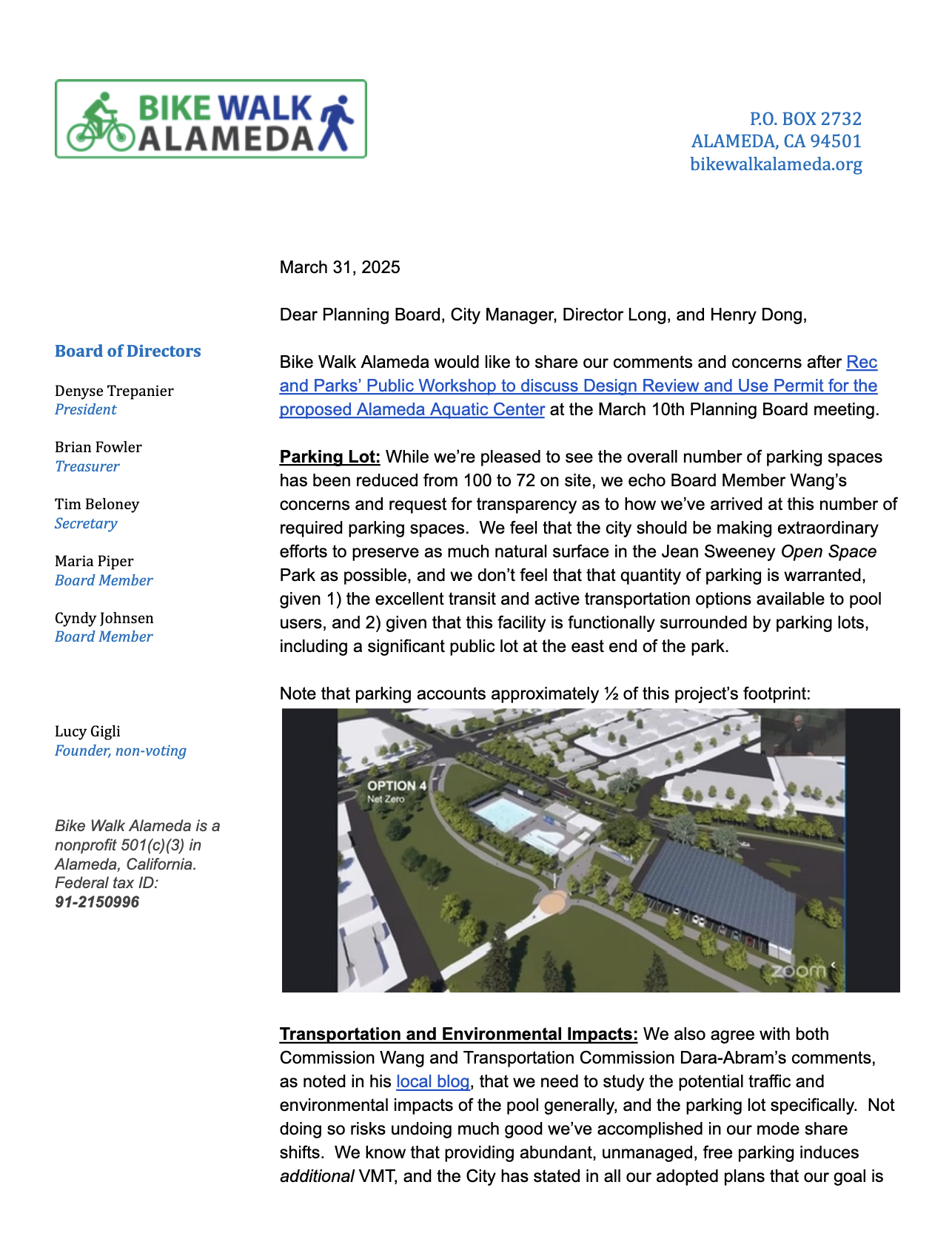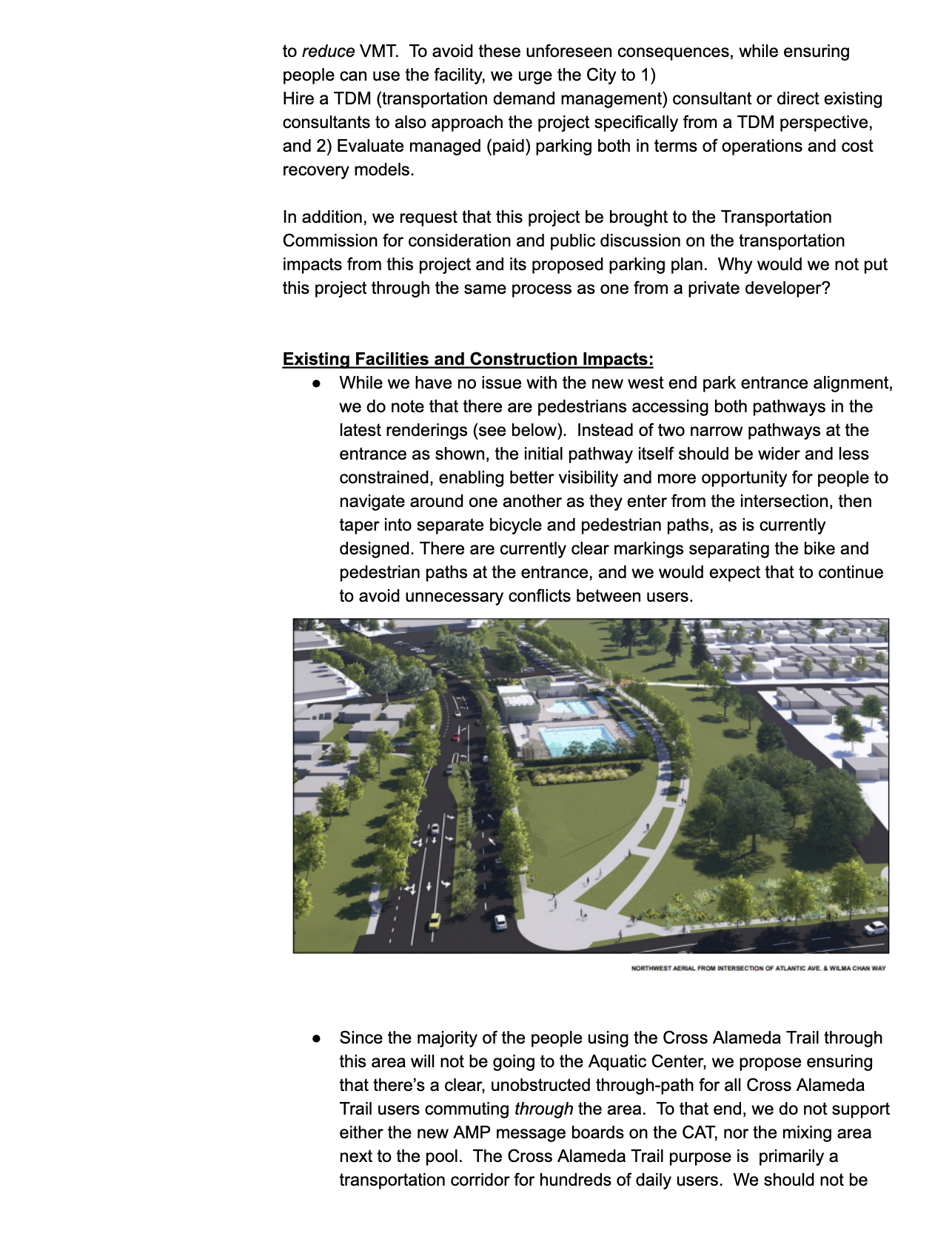Most every weekend over the past few months, my kids, spouse, and I have hung around Alameda's Krusi Park. It's a simple and straightforward park of grass, trees, playground, a couple picnic areas, and — the main reason for our recent presence — ball fields.
Pump, pump, pump it up!
PUMP, PUMP, PUMP IT UP!
Hi, girls — good to hear from you, but I'm trying to write a blog po—
Pump that softball spirit up!
PUMP THAT SOFTBALL SPIRIT UP!
As I was saying, my daughter has been playing softball this year and that's why most every weekend we've found ourselves at Krusi.
The other weekend, all 24 of the Alameda Girls Softball Association's recreational-level teams came to Krusi for awards and thanks to mark the end of the season.
The number of off-street parking spots provided at Krusi Park to support this large crowd? Zero.

Four games, a concert, and not a lot in sight
Over previous spring weekends, the four diamonds have held four simultaneous softball games — one day at the same exact time as Otis Elementary School held its "Owlapalooza" concert with professional musicians backing kids as they sang on the outdoor stage in a different part of Krusi. (I'd call it the Eras tour of Alameda, although this year there may have been almost as much Cure as Taylor Swift.)
It's a workhorse of a park — and it serves hundreds, if not low thousands, of kids and adults throughout a day without any off-street parking. Otis Elementary, which abuts the park also operates with zero off-street parking.
Keep, keep, keep it up!
KEEP, KEEP, KEEP IT UP!
Everyone reaches Krusi Park and Otis Elementary by walking, biking, taking transit, or parking their car on a public street. Before I forget to mention it, there are some painted blue curb areas for ADA accessible parki—
Keep that softball spirit up!
KEEP THAT SOFTBALL SPIRIT UP!
What if auto parking ate Krusi Park?
If I may interrupt, girls, I do want to offer a hypothetical. Imagine if Krusi Park had some off-street parking. First, it would come at the expense of at least one of the park's programmatic areas. Perhaps instead of four baseball/softball diamonds, there would be only three — with a field's worth of space dedicated instead to holding cars. Still, on busy days when the three remaining fields would be in use, or when parties would be held at the two picnic areas and in the rec building, then that lot would likely overflow. Or maybe Otis Elementary families would park in it during their open-house night (as recently lined up with the softball championship games). The neighbors might complain that the lot just wasn't big enough to handle all of the park users... and it really ought to be sufficiently large to prevent overflow. Next you know it, maybe two or three of the diamonds have been turned into parking, to ensure that no minivan need park on a public street...
Are you fired up?
Yes, we're fired up!
Thanks for stopping me from that dreadful line of hypothetical thinking, girls.
Fired up!
Fired up!
Desirable destinations don't need unlimited or free parking
Krusi Park — with its zero (0) spots of off-street parking — is a timely example for Alameda Recreation and Parks Department as they and their consultants plan for the new city aquatics center. In their most recent presentation to the Planning Board back in March, ARPD's team slightly scaled back the amount of park space they propose converting into paved parking for cars. However, they are still proposing to turn park land into parking — and to offering those parking spots for free.
Without managing that parking, ARPD is just setting up for a situation like the cycle I described in which one diamond becomes a parking lot... and then another... and then another. When parking is free, there's often never enough of it.
On the other hand, when parking is constrained at desirable destinations, people make do. In the case of Krusi, people park slightly further away on the grid of residential streets. Some softball families come with lots of gear for a day's worth of games, from chairs to folding tables to whole barbecue rigs. To surmount the challenge of getting from their car to the park they use a novel invention: a wagon!
A "customer" focus calls for professional advice
Excuse my sardonic tone — I'm using it because for the aquatic center I think some amount of planning of parking is based on ARPD's fears that they will lose customers if the walk from a minivan to the pool entrance involves too many steps.
Note the word customer. Like most California public services, the aquatic center will operate through "cost recovery." ARPD will need to sell enough entry tickets and enough classes and enough group reservations in order to cover the staff salaries and operational costs of the pool complex (which like many other ARPD programs won't be covered by the city's General Fund). More customers is not just nice, it's necessary. Without convenient parking, will the swimmers not come?
Questions like that are why the aquatic center planning team needs to be advised by an outside consultant or by other city departments who are experienced with transportation demand management (TDM) for public facilities. When a developer proposes a new shopping center or office building, the city expects this type of careful analysis — we should expect the same of the city's own developments.
A TDM consultant can estimate how many people may arrive by foot and bike (the Cross Alameda Trail is immediately next to the aquatic center).
A TDM consultant can also advise on options for how to "manage" auto parking at the aquatic center, if it does make sense to add a certain number of new off-street parking spots. As this blog's previous posts have proposed, charging for parking at the aquatic center would fit naturally into this overall budgeting approach — and would work toward our equity and climate goals. Plus, it actually would make it more convenient for those who really do want to drive and park near the entrance to the pools to pay for that privilege.
Here's a letter from Bike Walk Alameda making similar points, as well as providing context from the March meeting of the Planning Board:


When we build to prevent parking overflow, we just get emptiness
For decades, we've overbuilt off-street parking. We end up with places like South Shore Center, which is a small central set of buildings surrounded by a larger doughnut of pavement — parking that is never entirely full, since it was built so that there would never be an "overflow" of shoppers looking for parking on Black Friday. But for the other 364 days, much of that tarmac remains open — and in the 21st century retail environment, it's hardly needed on Black Friday either. Off-street auto parking is the dark energy of postwar American urban development, almost invisibly pushing houses and stores and offices further away from each other, further necessitating an auto for every trip.
If we instead go back and look at older places like Krusi Park, we can remember how popular destinations can operate, can be immensely popular, and can support our climate goals, without much — or any — off-street parking.
Fired up.
Fired up.
GO parking policy!
Thanks for helping jazz up my blog post, girls.
For those who are as fired up about parking policy as this blog is, there will be opportunities to provide public comments on ARPD's current plans to turn portions of Jean Sweeney Open Space Park into free auto parking at:
- this evening's Recreation and Parks Commission meeting
- a Planning Board meeting later in June
- a City Council meeting in July